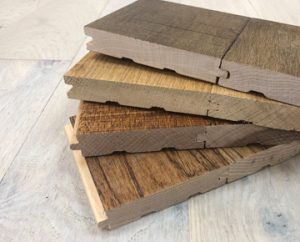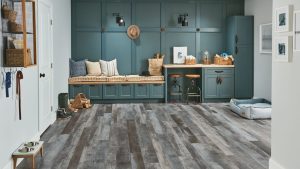Technology With Style: New Developments in Hardwood Flooring
Published: September 15, 2020
Hardwood flooring may be a traditional choice, but recent innovations have broadened the range of options beyond classic two-inch light-wood planks. From new species of wood to new materials, colors, textures, finishes and plank sizes, you can select from a wide range of products to suit your décor and budget.
Materials
The National Wood Flooring Association (NWFA) classifies wood flooring into solid, engineered and composite-engineered options. Solid wood is just that: planks cut from a tree. Engineered flooring contains multiple layers of plywood and a thinner top layer of wood, making it less likely than solid wood to expand and contract with temperature and humidity. Some engineered flooring uses tongue-and-groove systems for quick, simple snap-together installation.
Composite-engineered flooring contains wood only on the top surface, with virtually any type of composite material as the backing and core. The thin wood veneer on composite-engineered products may not qualify it as “real wood” for some consumers, but it can offer durability, water resistance and a good feel underfoot. If the top wearable layer is too thin, you’ll be unable to sand and refinish the floor more than once, if at all, unlike traditional hardwoods, which you can sand and refinish four to seven times, depending on plank thickness. Additionally, low humidity can cause the top layer of composite-engineered flooring to crack.
Unfinished or prefinished
Traditional wood flooring arrives as unfinished planks, with stains and sealants applied after installation and sanding. The upside of this process is the unified, solid look of the finished floor; the downside, the three or four days of drying time before you can walk on it. Prefinished flooring arrives from the factory fully sanded, stained and sealed, cutting installation time to as little as a single day.
Some prefinished hardwoods include subtly rounded, or beveled, edges that help mask any unevenness in the planks themselves or the installed floor. Because beveling leaves a minuscule gap between planks, however, it may be more likely to attract and retain dust, which may increase the amount of cleaning it requires.
In addition to natural and engineered woods, new environmentally friendly options include bamboo, cork and a composite material called Marmoleum, made from a combination of wood flour, limestone, jute and pigment.
Textures
Today’s hardwood flooring surfaces range from the high gloss of a piano finish to the familiar shine of regular sealants and even the low luster of a nearly matte look. In addition to the traditional smoothly sanded, knot-free appearance of solid hardwood, today’s choices include a diverse palette of textures that can give your floor a distinctive look. Wire-brushed wood looks weathered but not rustic or unfinished, and hides dirt to make floors easier to keep clean. Hand-scrubbed and hand-scraped finishes add a vintage look that makes each floor truly one of a kind.
Modern surface treatments can add visual interest, but for an even more striking interior, you also can select reclaimed wood, often from old gymnasiums or commercial buildings, and reproductions that give the look of age. Reactive stains quickly oxidize the tannins in wood to make new wood look like old hardwoods, typically using environmentally friendly salts such as iron chloride, also used to purify drinking water.
Traditional hardwood flooring uses knot-free lumber, but new options transform yesterday’s flaws into today’s design statement. Knots add what’s called “character” to hardwood flooring, ranging from knot-free clear boards to light character, all the way up to the knotty appearance of character grade.
Along with creating a customized look with surface treatments and textures, you can choose plank widths that range from traditionally narrow all the way up to 4″ or wider. Wider – and longer – planks make a dramatic statement in today’s open-plan interiors. Specialized installations can transform your floors with herringbone and chevron patterns or diagonally laid planks.
Today’s hardwoods broaden your design palette with materials, colors, textures, finishes and plank sizes to suit any style, room size and décor. For assistance in selecting the right choices to create the look you want, ask the design experts at Kermans Flooring to help you narrow down your options. Schedule a complimentary consultation or come in to see our lineup of hardwoods.

